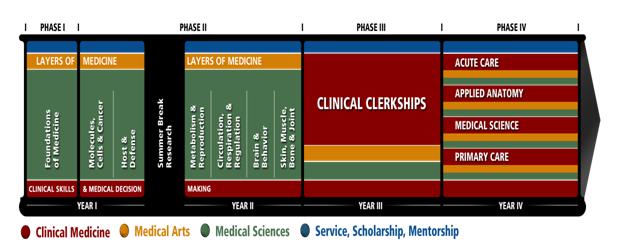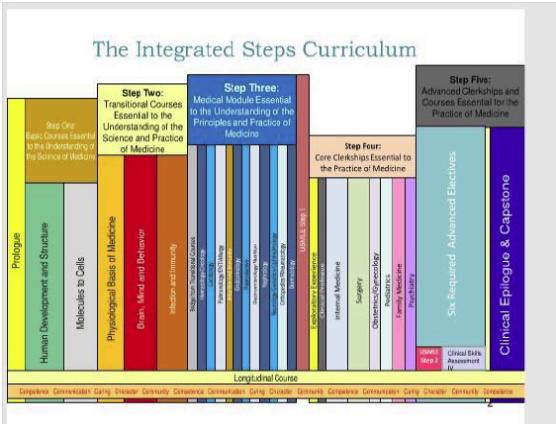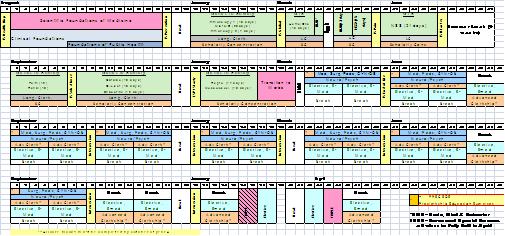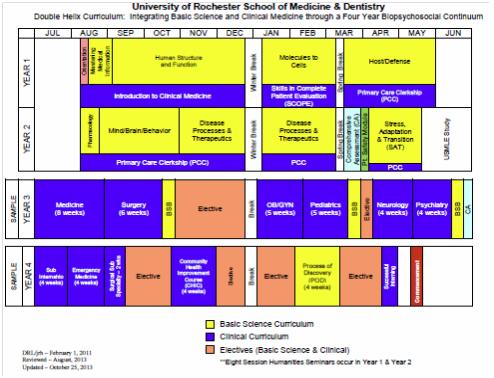Enews270 醫學院課程改革與課程整合之探討~ 醫學系課程整合的原則 Part 3
出自KMU e-News
| (17個中途的修訂版本沒有顯示。) | |||
| 第2行: | 第2行: | ||
第270期 | 第270期 | ||
分享園地 | 分享園地 | ||
| - | |||
| 第16行: | 第15行: | ||
範例 II. Northeastern Ohio University College of Medicine (NEOUCOM) – | 範例 II. Northeastern Ohio University College of Medicine (NEOUCOM) – | ||
| - | 整合的階段課程 (Integrated Steps Curriculum) | + | 整合的階段課程 (Integrated Steps Curriculum): |
*特色: | *特色: | ||
| - | #醫學系全部課程包括入門導引 (Prologue)、階段1-5 (Step1, Step 2, Step 3, Step 4, Step 5),以及縱貫課程 (Longitudinal course) | + | #醫學系全部課程包括入門導引 (Prologue)、階段1-5 (Step1, Step 2, Step 3, Step 4, Step 5),以及縱貫課程 (Longitudinal course) (如表七)。 |
#醫學系一年級與二年級課程包括入門導引與前三個階段 (Prologue、Step1、Step 2、Step 3)。醫學系三年級與四年級分别爲第四個階段 (Step 4) 與第五個階段 (Step 5)。縱貫課程是成醫課程 (On Doctoring),縱貫於全部四個學年課程。 | #醫學系一年級與二年級課程包括入門導引與前三個階段 (Prologue、Step1、Step 2、Step 3)。醫學系三年級與四年級分别爲第四個階段 (Step 4) 與第五個階段 (Step 5)。縱貫課程是成醫課程 (On Doctoring),縱貫於全部四個學年課程。 | ||
#每一個階段逐漸地變成更聚焦於臨床醫學。 | #每一個階段逐漸地變成更聚焦於臨床醫學。 | ||
#第一階段與第二階段主要是由基礎醫學教師授課,第三階段是採學組模式 (Block),一個學組為期 2-3 週,由臨床教師當課程協調者,而基礎醫學教師協助授課。 | #第一階段與第二階段主要是由基礎醫學教師授課,第三階段是採學組模式 (Block),一個學組為期 2-3 週,由臨床教師當課程協調者,而基礎醫學教師協助授課。 | ||
#每一個學組包含傳統的演講與主動學習部分 (例如小組活動、個案為基礎的學習)。 | #每一個學組包含傳統的演講與主動學習部分 (例如小組活動、個案為基礎的學習)。 | ||
| - | #第一階段 (Step 1): | + | #第一階段 (Step 1):瞭解醫學科學必要的基礎課程。 |
| - | + | ||
##Human Development and Structure. 13週。 | ##Human Development and Structure. 13週。 | ||
##Molecules to Cells. 7週。 | ##Molecules to Cells. 7週。 | ||
##Longitudinal Doctoring – is continuous through both academic years and includes a community preceptorship with a primary care physician. | ##Longitudinal Doctoring – is continuous through both academic years and includes a community preceptorship with a primary care physician. | ||
| - | #第二階段 (Step 2): | + | #第二階段 (Step 2):瞭解科學及執行醫療必要的過渡期的課程。 |
| - | + | ||
##Physiological Basis of Medicine. 7週。 | ##Physiological Basis of Medicine. 7週。 | ||
##Brain, Mind and Behavior: 8週。 | ##Brain, Mind and Behavior: 8週。 | ||
##Infection and Immunity: 7週。 | ##Infection and Immunity: 7週。 | ||
##Bridge from Transitional Courses: 1週。 | ##Bridge from Transitional Courses: 1週。 | ||
| - | #第三階段 (Step 3): | + | #第三階段 (Step 3):瞭解執行醫療與其原則必要的醫學模組課程。每一模組爲期 2-3週。 |
| - | + | ||
##Hematology/Oncology. | ##Hematology/Oncology. | ||
##Cardiology. | ##Cardiology. | ||
| 第50行: | 第46行: | ||
##Exploratory Experience: 2週。 | ##Exploratory Experience: 2週。 | ||
##Principles of Medicine Bridge course (Clinical Prologue): 1週。 | ##Principles of Medicine Bridge course (Clinical Prologue): 1週。 | ||
| - | #第四階段 (Step 4): | + | #第四階段 (Step 4):醫學系三年級。執行醫療必要的核心實習醫學生訓練。 |
| - | + | ||
##Internal Medicine: 9週。 | ##Internal Medicine: 9週。 | ||
##Surgery: 9週。 | ##Surgery: 9週。 | ||
| 第58行: | 第53行: | ||
##Family Medicine: 6週。 | ##Family Medicine: 6週。 | ||
##Psychiatric Medicine: 6週。 | ##Psychiatric Medicine: 6週。 | ||
| - | ##Longitudinal Course. | + | ##Longitudinal Course.(End of the third academic year) |
| - | (End of the third academic year) | + | #第五階段 (Step 5):醫學系四年級。執行醫療必要的階實習醫學生訓練與課程。 |
| - | #第五階段 (Step 5): | + | |
| - | + | ||
##Six Required Advanced Electives: | ##Six Required Advanced Electives: | ||
##Clinical Skills Assessment. | ##Clinical Skills Assessment. | ||
| - | ##Clinical Epilogue and Capstone: 包括 Practice of Medicine and Longitudinal | + | ##Clinical Epilogue and Capstone: 包括 Practice of Medicine and Longitudinal Course。共包含四個構成: Clinical Competency Information, Clinical Skills Development, Senior Class Service, and Critical Reflection。 |
| - | + | ##Longitudinal Course: 縱貫課程是教授 clinical skills, professionalism, communication, and ethics, etc.縱貫課程包括五個整合的主題: Physician Identity, Patient Care, Professionalism, Population Health, and Health。 | |
| - | ##Longitudinal Course: 縱貫課程是教授 clinical skills, professionalism, communication, and ethics, etc. | + | |
| - | + | ||
| 第73行: | 第64行: | ||
[[Image:enews270_劉克明-2.jpg]] | [[Image:enews270_劉克明-2.jpg]] | ||
| + | |||
| + | |||
| + | 3.廣濶的哲學為基礎的整合課程 (Broad-Based Philosophy-Integrated throughout the Curriculum):教學單元的構造以引導哲學 (guiding philosophy) 為基礎。 | ||
| + | |||
| + | 範例 I. The Johns Hopkins University School of Medicine – 從基因到社會課程(“Genes to Society”Curriculum). | ||
| + | *特色: | ||
| + | #課程之目標在更廣濶地重新建構健康與疾病的關係,意圖鼓勵學生在一個更大整合的課程,包括社會的、文化的、精神的、及環境的變數,去探討病人健康的生物特性。 | ||
| + | #此教學模式顯示病人的表現型狀 (patient’s phenotype) 是内部的 (基因、分子、細胞、與器官) 和外部的 (環境、家庭、及社會) 因素的共同決定。 | ||
| + | #横跨四個學年的縱貫課程與各個學習單元,皆以生物學的原則與環境的特性 (environmental individuality) 開始,而以社會對健康與疾病之間的連續之影響做結束。 | ||
| + | #横向課程分爲與生物醫學主題有關 (Biomedical strands),以及與社會與行爲的主題有關 (Social and Behavioral Strands)。分别如下: | ||
| + | ##Biomedical Strands:Anatomy, Embryology, Genomics/Proteomics, Imaging, Informatics, Neoplasia , Pathology , Pharmacology, Therapeutics。 | ||
| + | ##Social and Behavioral Strands:Communication, Cultural Competence, Epidemiology, Ethics & Professionalism, Health Disparities, Health Policy, Life Cycle: Aging, Life Cycle: Growth & Development, Nutrition, Pain, Patient Safety。 | ||
| + | ##課程强調公共衛生。 | ||
| + | ##銜接課程 (表八黄色部分) 包含有趣的特别主題,例如疾病預防、全身的健康、疼痛等。 | ||
| + | |||
| + | |||
| + | '''表八 The Johns Hopkins University School of Medicine – Genes to Society Curriculum.''' | ||
| + | |||
| + | [[Image:enews270_劉克明-3.jpg]] | ||
| + | |||
| + | |||
| + | 範例 II. 双螺旋課程 (Double-Helix Curriculum):University of Rochester School of Medicine & Dentistry設計且採行双螺旋整合課程 (Double helix curriculum)。 | ||
| + | *特色: | ||
| + | #以醫學的生物心理社會的模式為基礎 (Based on the biopsychosocial model of medicine) 的整合基礎科學與臨床醫學課程。 | ||
| + | #醫學系一年級及二年級的課程,從醫學生一入學開始,基礎科學與臨床科學即同時進行授課,在三年級及四年級的臨床教育時,又安排基礎科學的必修與選修課程 (Basic Science Blocks – BSBs; and Electives),將基礎科學與臨床科學整合交織貫穿於四個學年。 | ||
| + | #傳統上,該系醫學教育重視生物學的丶心理學的丶及社會等因素,以及它們在瞭解健康、疾病和醫療照護的提供之複雜的互動關係,並以培育自主、終身學習爲教育焦點。其双螺旋課程如表九所示。 | ||
| + | |||
| + | |||
| + | '''表九 双螺旋課程 (Double-Helix Curriculum) 範例:''' | ||
| + | |||
| + | [[Image:enews270_劉克明-4.jpg]] | ||
| + | |||
| + | |||
| + | 配合醫學院課程整合之相關政策的調整: | ||
| + | 2013年 5月,加拿大 University of Toronto Dr. Bandiera 等人於 Medical | ||
| + | Teacher 期刊發表“Integration and timing of basic and clinical sciences education.” | ||
| + | Dr. Bandiera 等人認爲以基礎科學加上臨床科學建構醫學教育是過時的,而且是未瞭解醫師能力的寬廣。他們提出“與其説某些科學是基礎的,不如說所有科學的領域,包括社會科學,都有基礎的與應用的成分。因此醫學教育應該採用基本的 (foundational) 與應用的 (applied) 科學的二分法。整合基本的與應用的科學的學習,將使醫學生獲得最大的參與學習和知識的保留。” | ||
| + | |||
| + | |||
| + | Dr. Bandiera 等人認爲醫學院的評鑑和執照的授與過程,會影響課程的設計,並引起相關的改變。例如,美國醫師執照考試第一階段基礎科學測驗 (USMLE Step 1 basic science examination),時間是在醫學系二年級結束時。這個測驗己經造成臨床前課程與臨床課程之間長久的分割。近年來,多數教育學者建議的美國醫師執照,將測驗改變爲查看兩個評量點。第一個評量點是在醫學院畢業前與畢業後的醫學教育之間的交接面,以被監督下的臨床醫療能力 (supervised practice) 爲範圍;第二個評量點是在畢業後開始獨立行醫時,以未受監督下的臨床醫療能力 (unsupervised practice) 爲範圍。而且採用與如同 ACGME 一般能力的國家標準一致的一般能力綱要(general competences schema),設計美國醫師執照考試的内容與評分。實施這些教育學者的建議,將創造一個單一的醫學系四年級能力爲基礎的測驗 (competency-based examination),如此,基礎科學才能真正地與臨床情境整合。理論上,此種美國醫師執照考試模式,將給醫學院更大的彈性,於他們如何去建構課程及促進縱向的課程整合。 | ||
| + | |||
| + | |||
| + | 結論: | ||
| + | 醫學院課程的改革是需要訂定明確的醫學教育理念、目標與目的,以及深思熟慮的規畫。除了卓越的領導者,必須借重團隊的合作,而相關的醫師執照考試的政策,也須配合醫學院課程改革而調整,課程改革才能順利成功。 | ||
| + | |||
| + | |||
| + | 参考資料: | ||
| + | #The Integrated Medical Curriculum (IMC) . http://www.ahc.umn.edu/img/assets/20825/CURRICULUM_final.pdf. (Access: 06.04.2015) | ||
| + | #Fogarty R. Ten ways to integrate curriculum. Educational Leadership. Skylight Publishing, Inc. pp. 61-65. Oct. 1991. http://www.ascd.org/ASCD/pdf/journals/ed_lead/el_199110_fogarty.pdf. (Access: 06.04.2015) | ||
| + | #U. Arizona COM curriculum. http://medicine.arizona.edu/education/md-program/blocks. (Access: 06.04.2015) | ||
| + | #UCLA David Geffen School of Medicine. Curriculum. http://dgsom.healthscience.ucla.edu/education/md/curriculum-phase-one. (Access: 06.04.2015) | ||
| + | #University of Utah School of Medicine. Curriculum. http://medicine.utah.edu/medicaleducation/curriculum/curriculum_overview.php. (Access: 06.04.2015) | ||
| + | #Northeastern Ohio University College of Medicine. Curriculum. http://www.neomed.edu/admissions/medicine/direct/curr-md. (Access: 06.04.2015) | ||
| + | #Johns Hopkins University School of Medicine –“Genes to Society”curriculum. http://www.hopkinsmedicine.org/crc. (Access: 06.04.2015) | ||
| + | #Curriculum. University of Rochester School of Medicine & Dentistry. https://www.urmc.rochester.edu/education/md/admissions/md-curriculum.cfm. (Access: 06.04.2015) | ||
| + | #Bandiera G., Boucher A., Neville A., Kuper A., Hodges B. Integration and timing of basic and clinical sciences education. Medical Teacher. 35 (5): 381-387, 2013. http://www.ncbi.nlm.nih.gov/pubmed/23444888. (Access: 06.04.2015) | ||
| + | #[[enews265 醫學院課程改革與課程整合之探討 Part 1]] 高雄醫學大學e快報 265期. (05.13.2015 出刊) | ||
| + | #[[enews266 課程改革與課程整合之探討 Part 2]] 高雄醫學大學e快報 266期. (05.27.2015 出刊) | ||
| + | |||
| + | |||
| + | [[enews270]] | ||
| + | |||
| + | [[Category:分享園地]] | ||
| + | |||
| + | [[Category:劉克明]] | ||
當前修訂版本
高雄醫學大學e快報 第270期 分享園地
醫學院課程改革與課程整合之探討~ 醫學系課程整合的原則 Part 3
醫學院 劉克明教授
表六 Curriculum of University of Utah School of Medicine:
範例 II. Northeastern Ohio University College of Medicine (NEOUCOM) –
整合的階段課程 (Integrated Steps Curriculum):
- 特色:
- 醫學系全部課程包括入門導引 (Prologue)、階段1-5 (Step1, Step 2, Step 3, Step 4, Step 5),以及縱貫課程 (Longitudinal course) (如表七)。
- 醫學系一年級與二年級課程包括入門導引與前三個階段 (Prologue、Step1、Step 2、Step 3)。醫學系三年級與四年級分别爲第四個階段 (Step 4) 與第五個階段 (Step 5)。縱貫課程是成醫課程 (On Doctoring),縱貫於全部四個學年課程。
- 每一個階段逐漸地變成更聚焦於臨床醫學。
- 第一階段與第二階段主要是由基礎醫學教師授課,第三階段是採學組模式 (Block),一個學組為期 2-3 週,由臨床教師當課程協調者,而基礎醫學教師協助授課。
- 每一個學組包含傳統的演講與主動學習部分 (例如小組活動、個案為基礎的學習)。
- 第一階段 (Step 1):瞭解醫學科學必要的基礎課程。
- Human Development and Structure. 13週。
- Molecules to Cells. 7週。
- Longitudinal Doctoring – is continuous through both academic years and includes a community preceptorship with a primary care physician.
- 第二階段 (Step 2):瞭解科學及執行醫療必要的過渡期的課程。
- Physiological Basis of Medicine. 7週。
- Brain, Mind and Behavior: 8週。
- Infection and Immunity: 7週。
- Bridge from Transitional Courses: 1週。
- 第三階段 (Step 3):瞭解執行醫療與其原則必要的醫學模組課程。每一模組爲期 2-3週。
- Hematology/Oncology.
- Cardiology.
- Pulmonology/ENT/Allergy.
- Infection and Immunity.
- Endocrinology.
- Reproductive.
- Gastroenterology/Nutrition.
- Nephrology.
- Neurology/Geriatrics/Ophthalmology.
- Orthopedics/Rheumatology.
- Dermatology (End of 2nd. Year)
- Preparation of USMLE Step 1 examination.
- Exploratory Experience: 2週。
- Principles of Medicine Bridge course (Clinical Prologue): 1週。
- 第四階段 (Step 4):醫學系三年級。執行醫療必要的核心實習醫學生訓練。
- Internal Medicine: 9週。
- Surgery: 9週。
- OBS/GYN: 6週。
- Pediatric Medicine: 6週。
- Family Medicine: 6週。
- Psychiatric Medicine: 6週。
- Longitudinal Course.(End of the third academic year)
- 第五階段 (Step 5):醫學系四年級。執行醫療必要的階實習醫學生訓練與課程。
- Six Required Advanced Electives:
- Clinical Skills Assessment.
- Clinical Epilogue and Capstone: 包括 Practice of Medicine and Longitudinal Course。共包含四個構成: Clinical Competency Information, Clinical Skills Development, Senior Class Service, and Critical Reflection。
- Longitudinal Course: 縱貫課程是教授 clinical skills, professionalism, communication, and ethics, etc.縱貫課程包括五個整合的主題: Physician Identity, Patient Care, Professionalism, Population Health, and Health。
表七 Northeastern Ohio University College of Medicine (NEOUCOM) – 整合的階段課程:
3.廣濶的哲學為基礎的整合課程 (Broad-Based Philosophy-Integrated throughout the Curriculum):教學單元的構造以引導哲學 (guiding philosophy) 為基礎。
範例 I. The Johns Hopkins University School of Medicine – 從基因到社會課程(“Genes to Society”Curriculum).
- 特色:
- 課程之目標在更廣濶地重新建構健康與疾病的關係,意圖鼓勵學生在一個更大整合的課程,包括社會的、文化的、精神的、及環境的變數,去探討病人健康的生物特性。
- 此教學模式顯示病人的表現型狀 (patient’s phenotype) 是内部的 (基因、分子、細胞、與器官) 和外部的 (環境、家庭、及社會) 因素的共同決定。
- 横跨四個學年的縱貫課程與各個學習單元,皆以生物學的原則與環境的特性 (environmental individuality) 開始,而以社會對健康與疾病之間的連續之影響做結束。
- 横向課程分爲與生物醫學主題有關 (Biomedical strands),以及與社會與行爲的主題有關 (Social and Behavioral Strands)。分别如下:
- Biomedical Strands:Anatomy, Embryology, Genomics/Proteomics, Imaging, Informatics, Neoplasia , Pathology , Pharmacology, Therapeutics。
- Social and Behavioral Strands:Communication, Cultural Competence, Epidemiology, Ethics & Professionalism, Health Disparities, Health Policy, Life Cycle: Aging, Life Cycle: Growth & Development, Nutrition, Pain, Patient Safety。
- 課程强調公共衛生。
- 銜接課程 (表八黄色部分) 包含有趣的特别主題,例如疾病預防、全身的健康、疼痛等。
表八 The Johns Hopkins University School of Medicine – Genes to Society Curriculum.
範例 II. 双螺旋課程 (Double-Helix Curriculum):University of Rochester School of Medicine & Dentistry設計且採行双螺旋整合課程 (Double helix curriculum)。
- 特色:
- 以醫學的生物心理社會的模式為基礎 (Based on the biopsychosocial model of medicine) 的整合基礎科學與臨床醫學課程。
- 醫學系一年級及二年級的課程,從醫學生一入學開始,基礎科學與臨床科學即同時進行授課,在三年級及四年級的臨床教育時,又安排基礎科學的必修與選修課程 (Basic Science Blocks – BSBs; and Electives),將基礎科學與臨床科學整合交織貫穿於四個學年。
- 傳統上,該系醫學教育重視生物學的丶心理學的丶及社會等因素,以及它們在瞭解健康、疾病和醫療照護的提供之複雜的互動關係,並以培育自主、終身學習爲教育焦點。其双螺旋課程如表九所示。
表九 双螺旋課程 (Double-Helix Curriculum) 範例:
配合醫學院課程整合之相關政策的調整:
2013年 5月,加拿大 University of Toronto Dr. Bandiera 等人於 Medical
Teacher 期刊發表“Integration and timing of basic and clinical sciences education.”
Dr. Bandiera 等人認爲以基礎科學加上臨床科學建構醫學教育是過時的,而且是未瞭解醫師能力的寬廣。他們提出“與其説某些科學是基礎的,不如說所有科學的領域,包括社會科學,都有基礎的與應用的成分。因此醫學教育應該採用基本的 (foundational) 與應用的 (applied) 科學的二分法。整合基本的與應用的科學的學習,將使醫學生獲得最大的參與學習和知識的保留。”
Dr. Bandiera 等人認爲醫學院的評鑑和執照的授與過程,會影響課程的設計,並引起相關的改變。例如,美國醫師執照考試第一階段基礎科學測驗 (USMLE Step 1 basic science examination),時間是在醫學系二年級結束時。這個測驗己經造成臨床前課程與臨床課程之間長久的分割。近年來,多數教育學者建議的美國醫師執照,將測驗改變爲查看兩個評量點。第一個評量點是在醫學院畢業前與畢業後的醫學教育之間的交接面,以被監督下的臨床醫療能力 (supervised practice) 爲範圍;第二個評量點是在畢業後開始獨立行醫時,以未受監督下的臨床醫療能力 (unsupervised practice) 爲範圍。而且採用與如同 ACGME 一般能力的國家標準一致的一般能力綱要(general competences schema),設計美國醫師執照考試的内容與評分。實施這些教育學者的建議,將創造一個單一的醫學系四年級能力爲基礎的測驗 (competency-based examination),如此,基礎科學才能真正地與臨床情境整合。理論上,此種美國醫師執照考試模式,將給醫學院更大的彈性,於他們如何去建構課程及促進縱向的課程整合。
結論:
醫學院課程的改革是需要訂定明確的醫學教育理念、目標與目的,以及深思熟慮的規畫。除了卓越的領導者,必須借重團隊的合作,而相關的醫師執照考試的政策,也須配合醫學院課程改革而調整,課程改革才能順利成功。
参考資料:
- The Integrated Medical Curriculum (IMC) . http://www.ahc.umn.edu/img/assets/20825/CURRICULUM_final.pdf. (Access: 06.04.2015)
- Fogarty R. Ten ways to integrate curriculum. Educational Leadership. Skylight Publishing, Inc. pp. 61-65. Oct. 1991. http://www.ascd.org/ASCD/pdf/journals/ed_lead/el_199110_fogarty.pdf. (Access: 06.04.2015)
- U. Arizona COM curriculum. http://medicine.arizona.edu/education/md-program/blocks. (Access: 06.04.2015)
- UCLA David Geffen School of Medicine. Curriculum. http://dgsom.healthscience.ucla.edu/education/md/curriculum-phase-one. (Access: 06.04.2015)
- University of Utah School of Medicine. Curriculum. http://medicine.utah.edu/medicaleducation/curriculum/curriculum_overview.php. (Access: 06.04.2015)
- Northeastern Ohio University College of Medicine. Curriculum. http://www.neomed.edu/admissions/medicine/direct/curr-md. (Access: 06.04.2015)
- Johns Hopkins University School of Medicine –“Genes to Society”curriculum. http://www.hopkinsmedicine.org/crc. (Access: 06.04.2015)
- Curriculum. University of Rochester School of Medicine & Dentistry. https://www.urmc.rochester.edu/education/md/admissions/md-curriculum.cfm. (Access: 06.04.2015)
- Bandiera G., Boucher A., Neville A., Kuper A., Hodges B. Integration and timing of basic and clinical sciences education. Medical Teacher. 35 (5): 381-387, 2013. http://www.ncbi.nlm.nih.gov/pubmed/23444888. (Access: 06.04.2015)
- enews265 醫學院課程改革與課程整合之探討 Part 1 高雄醫學大學e快報 265期. (05.13.2015 出刊)
- enews266 課程改革與課程整合之探討 Part 2 高雄醫學大學e快報 266期. (05.27.2015 出刊)




